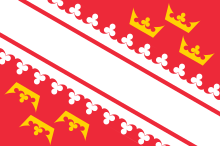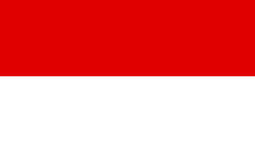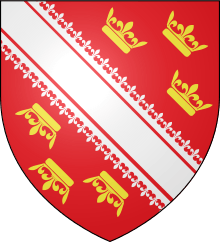Flag of Alsace
.svg.png) | |
| Name | Rot un Wiss |
|---|---|
| Adopted | 11th century |
| Design | Red and white |
| Designed by | Gérard d'Alsace, Duke of Lorraine |
| Part of the series on |
| Alsace |
|---|
.svg.png) Rot un Wiss, flag of Alsace since 11th century. |
|
(including Lorraine) |
|
|
Alsace in the EU |
|
Related topics |
|
.svg.png)

The flag of Alsace (Alsatian: Rot un Wiss or 'Rot-un-Wiss', "red and white") is the original red and white flag of the region, and can be traced to the red and white banner of Gérard d'Alsace, Duke of Lorraine in the 11th century.
Particularly since the introduction of new French region Grand Est, the traditional Rot un Wiss flag has been widely promoted by the advocates of the Alsace autonomous movement.
History
Rot un Wiss (from the 11th century)
The original flag of Alsace, the Rot un Wiss, dates back to the red and white banner[1] of Gérard d'Alsace, Duke of Lorraine in the 11th century.
Red and white colours are commonly found on the coat of arms of Alsatian cities such as Strasbourg, Mulhouse and Sélestat,[2] and additionally of many Swiss cites, especially in the region of Basel-Landschaft.
Departments flag (1949-2008)
Perhaps as the Rot un Wiss marks the Germanic roots of Alsace, it was replaced in 1949 by a new "Union jack-like" flag, representing the union of the two départements of Haut-Rhin and Bas-Rhin, however without real historical relevance. It was subsequently modified to a slightly different appearance, yet also representing the two departments.
Controversy
There is controversy around the recognition of the Alsatian flag.
With the purpose of "Frenchizing" the region, the Rot un Wiss has not been recognised by Paris. Some zealous statesmen have called this a "Nazi invention" — while the Rot un Wiss is still known as the real historical emblem of the region by most of the population and the departments' parliaments.
Subsequently, the Rot un Wiss has been widely used during protests against the creation of a new "super-region" Grand Est, gathering Champagne-Ardennes, Lorraine and Alsace, namely on Colmar's statue of liberty.[3]
Similar flags
Except for its proportions, the flag is similar to a few other ones around the world.
-

Flag of Vorarlberg, Austria
-

Flag of Monaco, 1881
-

Flag of Kerkrade, Netherlands
-

Landesflagge of Hesse, Germany, 1948
-

Flag of Canton of Solothurn, Switzerland




